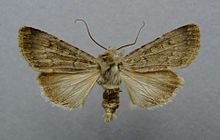Light gray earth owl
| Light gray earth owl | ||||||||||||
|---|---|---|---|---|---|---|---|---|---|---|---|---|

Light gray earth owl ( Euxoa decora ) |
||||||||||||
| Systematics | ||||||||||||
|
||||||||||||
| Scientific name | ||||||||||||
| Euxoa (Euxoa) decora | ||||||||||||
| ( Denis & Schiffermüller , 1775) |
The light gray earth owl ( Euxoa decora ), also called bluish gray earth owl , is a butterfly ( moth ) from the owl butterfly family (Noctuidae).
features
The wingspan of the butterfly is 32 to 44 millimeters, depending on the subspecies. The color of the forewings varies in different shades of gray, from light gray to yellow-gray or blue-gray to dark gray. Ring and kidney defects are often yellowish, but mostly indistinct. Spigot flaws are not recognizable. Cross and wavy lines are darkened or blurred. The hind wings are white-gray to gray-brown in color, e.g. Sometimes with dark bands in the hem area.
- Euxoa decora decora , 38 to 41 mm wingspan, basic color of the forewings ash-gray, ring and kidney flaws not clear, whitish to yellowish, no cones flaws, edge line weak
- Euxoa decora simulatrix (Hübner, 1824), 36 to 40 mm wingspan, basic color of the forewings dark gray, clear transverse lines, blemishes and middle shadows clearly recognizable
- Euxoa decora splendida (Turati, 1912), 35 to 40 mm wingspan, wide forewing with rounded apex, basic color of the forewings light gray with light brown admixtures
- Euxoa decora macedonica Thurner, 1936, 34 to 38 mm wingspan, transverse lines and blemishes blurred, hardly developed, basic color of the front wings gray with yellowish admixtures
- Euxoa decora olympica (Tuleschkow, 1951), 32 to 38 mm wingspan, basic color of the forewings dark, dusty black, weak transverse lines, flaws yellowish
- Euxoa decora hackeri Fibiger & Moberg, 1990, 43 to 44 mm wingspan, basic color of the forewings light gray, clearly developed blemishes and transverse lines, hindwings light with a narrow, dark band in the fringe area.
The egg is gray-brown with no ribs on the surface.
The caterpillars have a yellow-gray color, a dark back line and dark point warts. The relatively small head is yellow-brown. The head and pronotum are marked with black spots.
The pupa is light brown to red brown. It has two short thorns on the pointed cremaster .
Similar species
Some species also with a gray basic color, for example Agrotis simplonia , Euxoa birivia , Rhyacia helvetina , the ash gray earth owl ( Agrotis cinerea ), the mountain meadow ground owl ( Epipsilia grisescens ) and the ash gray ground owl ( Xestia ashworthii ssp. Candelarum ) are similar to the light gray owl . If their yellow blemishes are only vaguely pronounced, specialists should be consulted to ensure that they are correctly identified.
Geographical distribution and habitat
The species occurs in mountains and mountainous areas of northwest Africa (Algeria, Morocco), southern Europe and the Middle East (Armenia, Turkey, Iraq, Iran). In the east the distribution area extends to Issyk-Kul . In the Alps it rises to an altitude of 2000 meters. Preferred habitat are rocky slopes, stony grasslands and scree slopes with little vegetation, e.g. Sometimes even above the tree line.
Way of life
The nocturnal moths fly regionally differently from June to October in one generation. The moths of the subspecies E. (E.) decora hackeri usually hold a summer break in July and August. They come to artificial light sources and visit the bait . The caterpillars feed mostly on the roots of various herbaceous plants and grasses, such as skipjack kidney vetch ( Anthyllis vulneraria ). They overwinter and pupate in a cave in June of the following year.
Danger
In Germany, the mountain meadow owl occurs in Bavaria , where it can also occur in large numbers locally. She can also be found in Baden-Württemberg . The very variable moths of the Swabian Alb habitually match both the ssp. decora as well as the ssp. simulatrix and are listed there on the red list of endangered species on the warning list.
Systematics
The mountain meadow ground owl is divided into several subspecies with the following main occurrence areas:
- Euxoa decora decora , the nominate subspecies in the Eastern Alps with subsequent eastern regions, the foothills of the Alps and northern Italy ,
- Euxoa decora simulatrix (Hübner, 1824), in the Western Alps and the Pyrenees ,
- Euxoa decora splendita (Turati, 1912), in Abruzzo ,
- Euxoa decora macedonica Thurner, 1936, in the mountains along the southeast coast of the Adriatic Sea and in northwest and southern Greece ,
- Euxoa decora olympica (Tuleschkow, 1951), in large parts of central Greece,
- Euxoa decora hackeri Fibiger & Moberg, 1990, in the Falakron Mountains in north-central Greece.
swell
Individual evidence
- ↑ Red lists at Science4you
- ↑ a b Fibiger (1990: pp. 55–57)
- ↑ a b c d Forster and Wohlfahrt (1971: p. 10/1).
- ↑ Axel Steiner in Ebert (1998: pp. 503–505)
- ↑ Federal Agency for Nature Conservation (Ed.): Red List of Endangered Animals in Germany . Landwirtschaftsverlag, Münster 1998, ISBN 3-89624-110-9 .
literature
- Michael Fibiger: noctuinae I . In: WG Tremewan (Ed.): Noctuidae Europaeae . 1st edition. tape 1 . Entomological Press, Sorø 1990, ISBN 87-89430-01-8 (English).
- Günter Ebert (Ed.): The butterflies of Baden-Württemberg . 1st edition. tape 7 . Moth V Noctuidae 3rd part. Ulmer, Stuttgart (Hohenheim) 1998, ISBN 3-8001-3500-0 .
- Walter Forster , Theodor A. Wohlfahrt : The butterflies of Central Europe. Volume 4: Owls. (Noctuidae). Franckh'sche Verlagshandlung, Stuttgart 1971, ISBN 3-440-03752-5 .
Web links
- www.lepiforum.de - photos
- www.schmetterlinge-deutschlands.de - endangerment
- Euxoa decora at Fauna Europaea
